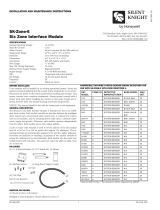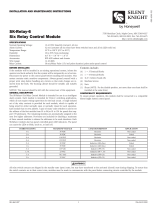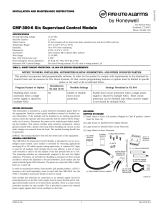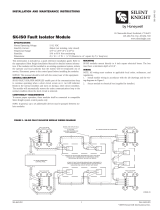
INSTALLATION AND MAINTENANCE INSTRUCTIONS
BEFORE INSTALLING
This information is included as a quick reference installation guide. If the
modules will be installed in an existing operational system, inform the op-
erator and local authority that the system will be temporarily out of service.
Disconnect the power to the control panel before installing the modules. This
system contains static sensitive components. Always ground yourself with a
proper wrist strap before handling any circuits so that static charges are re-
moved from the body. The housing cabinet should be metallic and suitably
grounded.
NOTICE: This manual should be left with the owner/user of this equipment.
GENERAL DESCRIPTION
The ISO-6 Six Fault Isolator Module provides six equivalent circuits that will
allow a portion of the communications loop to continue operating when a
short circuit occurs on that loop. An amber LED indicator will blink in the
noromal state for each of the six inputs and will latch on during a short circuit
condition. The module will automatically restore the communications loop to
normal condition when the short circuit is removed.
CONTENTS INCLUDE:
(6) 1 x 4 Terminal Blocks
(2) 1¼˝ (32mm) Stand offs
(4) Machine Screws
(2) Nuts
COMPATIBILITY REQUIREMENTS
To ensure proper operation, this module shall be connected to a compatible
control panel only.
NOTE: The number of devices that may be installed between fault isolator
modules will vary based on the types of devices on the loop. Contact your
Fire Alarm Panel manufacturer or refer to your device manual for the correct
isolator load ratings of individual devices. When added together, the sum of
all isolator load ratings of the devices between fault isolator modules should
not exceed 1.
COMPONENTS
Following are descriptions of the ISO-6 mounting frameworks. There are two
mounting options for ISO-6 modules:
• Up to six ISO-6 modules can be installed on a CH-6 in a BB-6 cabinet
• One or two ISO-6 modules can be installed in a BB-2 cabinet
Chassis
The CH-6 chassis is used to mount ISO-6 modules in a BB-6 cabinet. It accom-
modates up to six ISO-6 modules in a single cabinet row three modules wide
and two modules deep.
ISO-6 Six Fault Isolator Module
SPECIFICATIONS
Normal Operating Voltage: 15-32 VDC
Stand-By Current: 450 microA per circuit, 2.7 mA all circuits
Maximum Current Draw: 17 mA per circuit in isolation, 102 mA with all circuits in isolation
Temperature Range: 32°F to 120°F (0°C to 49°C)
Humidity: 10 to 93% Non-condensing
Dimensions: 6.8˝H × 5.8˝W × 1.0˝D
Accessories: BB-2 Cabinet; BB-6 Cabinet; CH-6 Chassis
Wire Gauge: 12-18 AWG
3825 Ohio Avenue, St. Charles, Illinois 60174
1-800-SENSOR2, FAX: 630-377-6495
www.systemsensor.com
FIGURE 1: CH-6 CHASSIS
The BB-2 cabinet has a built-in chassis that will accommodate one or two
ISO-6 modules.
FIGURE 2: BB-2 CABINET
The front ISO-6 module positions of each chassis are offset below the rear
ISO-6 module positions so that all of the status indicators are visible.
Cabinets
A BB-6 cabinet will house the CH-6 chassis with up to six ISO-6 modules
installed on it.
The BB-2 cabinet houses one or two ISO-6 modules on the internal chassis that
is part of the cabinet. Refer to cabinet installation documents for dimensions.
I56-4096-002
C0206-00
C0234-06
1 I56-4096-002
03-11

FIGURE 6B: INSTALLATION OF ISO-6 MODULE IN FRONT CHASSIS POSI-
TION
2
1
3
Step 1: Insert the bottom edge of the ISO-6 module down into a front slot of
the chassis.
Step 2: Carefully swing the upper edge of the board towards the back of the
chassis until it touches the 1
1
/4˝ (31.75mm) standoffs installed on the
rear module.
Step 3: Align two 4-40 screws with the two standoffs and tighten.
Step 4: Wire the modules according to the instructions in this manual.
WIRING
NOTE: All wiring must conform to applicable local codes, ordinances, and
regulations.
1. Install module wiring in accordance with the job drawings and appropri-
ate wiring diagrams.
2. Make electrical connections by stripping approximately
1
/4˝ (6.35mm) of
insulation from the end of the wire sliding the bare end of the wire under
the clamping plate, and tightening the clamping plate screw.
NOTE: All references to power limited represent “Power Limited (Class 2)”.
C0245-01
6.8"
5.8"
FROM PANEL
OR PREVIOUS DEVICE
SIGNAL LINE CIRCUIT
32 VDC MAX.
TWISTED PAIR
IS RECOMMENDED
TO NEXT
DEVICE
–
+
–
+
–
+
STATUS
INDICATORS
FIGURE 7: WIRING AND PROGRAMMING THE ISO-6 MODULE
C0205-05
2 I56-4096-002
03-11

INSTALLATION STEPS
1. Cabinet Mounting
FIGURE 3: TYPICAL MOUNTING HOLE LOCATIONS
BACKBOX
MOUNTING
HOLES
In a clean, dry area, mount the backbox using the four holes provided in the
back surface of the cabinet.
2. Chassis Installation
The CH-6 chassis is mounted in the BB-6 cabinet. It is shipped with two self-
threading screws, which are used to fasten the chassis to the back wall of the
cabinet (see Figure 4).
FIGURE 4: MOUNTING THE CH-6 CHASSIS
MOUNT WITH
SELF-THREADING SCREWS
TO BACK OF CABINET
The BB-2 cabinet comes with the chassis already installed, so no mounting
is necessary.
3. Module Installation
There are two methods for installing a module in the rear position of a chas-
sis. Method one is for installation of a rear module only, when no module will
be installed in front of it. Refer to Figure 5 for instructions. Method two is for
installation of a rear module when another module will be installed in the
chassis position in front of it. Refer to Figures 6a and 6b for method two. All
necessary screws and standoffs are supplied with the modules.
FIGURE 5: INSTALLATION OF REAR MODULE ONLY, METHOD ONE
2
1
3
Step 1: Insert the bottom of the ISO-6 module down into a rear slot on the
chassis.
Step 2: Carefully swing the upper edge of the board back towards the back of
the chassis until it touches the two standoffs.
Step 3: Align two 4-40 screws with the two standoffs and tighten.
Step 4: Wire the modules according to the instructions in this manual.
The steps in Figures 6a and 6b describe and illustrate module installation
when the rear chassis position and the position in front of it will be filled.
Front position installation is possible only if the rear position is filled with an
input/output module.
FIGURE 6A: INSTALLATION OF ISO-6 MODULE IN A REAR CHASSIS
POSITION, METHOD TWO
1
Step 1: Insert the bottom edge of the ISO-6 module down into a rear slot of
the chassis.
Step 2: Carefully swing the upper edge of the board towards the back of the
chassis until it touches the short standoff attached to the chassis.
Step 3: Align the long standoff with the short standoff and tighten.
C0235-00
C0236-00
C0243-01
C0244-01
3 I56-4096-002
03-11

FCC STATEMENT
This device complies with part 15 of the FCC Rules. Operation is subject to the following two conditions: (1) This device may not cause harmful interference, and (2) this device must
accept any interference received, including interference that may cause undesired operation.
NOTE: This equipment has been tested and found to comply with the limits for a Class B digital device, pursuant to Part 15 of the FCC Rules. These limits are designed to provide
reasonable protection against harmful interference in a residential installation. This equipment generates, uses and can radiate radio frequency energy and, if not installed and used
in accordance with the instructions, may cause harmful interference to radio communications. However, there is no guarantee that interference will not occur in a particular installa
-
tion. If this equipment does cause harmful interference to radio or television reception, which can be determined by turning the equipment off and on, the user is encouraged to try
to correct the interference by one or more of the following measures:
– Reorient or relocate the receiving antenna.
– Increase the separation between the equipment and receiver.
– Connect the equipment into an outlet on a circuit different from that to which the receiver is connected.
– Consult the dealer or an experienced radio/TV technician for help.
THREE-YEAR LIMITED WARRANTY
System Sensor warrants its enclosed module to be free from defects in materials and
workmanship under normal use and service for a period of three years from date of
manufacture. System Sensor makes no other express warranty for this module. No agent,
representative, dealer, or employee of the Company has the authority to increase or alter
the obligations or limitations of this Warranty. The Company’s obligation of this Warranty
shall be limited to the repair or replacement of any part of the module which is found to
be defective in materials or workmanship under normal use and service during the three
year period commencing with the date of manufacture. After phoning System Sensor’s
toll free number 800-SENSOR2 (736-7672) for a Return Authorization number, send
defective units postage prepaid to: Honeywell, 12220 Rojas Drive, Suite 700, El Paso TX
79936 USA. Please include a note describing the malfunction and suspected cause of fail
-
ure. The Company shall not be obligated to repair or replace units which are found to be
defective because of damage, unreasonable use, modifications, or alterations occurring
after the date of manufacture. In no case shall the Company be liable for any consequen
-
tial or incidental damages for breach of this or any other Warranty, expressed or implied
whatsoever, even if the loss or damage is caused by the Company’s negligence or fault.
Some states do not allow the exclusion or limitation of incidental or consequential dam
-
ages, so the above limitation or exclusion may not apply to you. This Warranty gives you
specific legal rights, and you may also have other rights which vary from state to state.
4 I56-4096-002
©2016 System Sensor. 03-11
/





